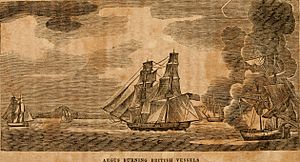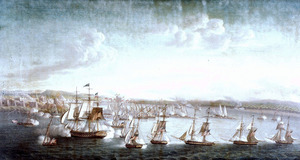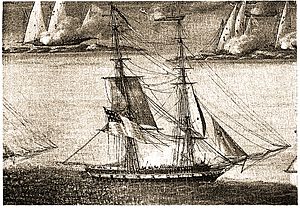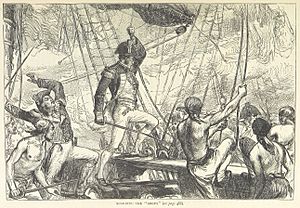USS Argus (1803) facts for kids

Argus during the War of 1812
|
|
Quick facts for kids History |
|
|---|---|
| Name | USS Merrimack |
| Namesake | The Merrimack River in Massachusetts and New Hampshire |
| Ordered | 29 April 1803 |
| Builder | Edmund Hartt |
| Cost | $37,428 |
| Laid down | 12 May 1803 |
| Launched | 31 August 1803 |
| Commissioned | 6 September 1803 |
| Renamed | USS Argus 4 June 1803 |
| Namesake | Argus Panoptes, in Greek mythology a monster with a hundred eyes slain by the messenger of the gods Hermes |
| Launched | 21 August 1803 |
| Commissioned | August or September 1803 |
| Out of service | 1806 (in ordinary) |
| In service | 1807 (returned to full commission) |
| Fate | Captured 14 August 1813 |
| General characteristics | |
| Type | Brig |
| Tons burthen | 299 (bm) |
| Length |
|
| Beam | 28 ft 2 in (8.59 m) |
| Depth of hold | 12 ft 8 in (3.86 m) |
| Propulsion | Sail |
| Complement | 142 officers and enlisted |
| Armament |
|
The first USS Argus, originally named USS Merrimack, was a brig (a type of sailing ship) in the United States Navy. It was put into service in 1803. This ship helped enforce the Embargo Act of 1807, which stopped trade with other countries. It also fought in the First Barbary War, helping to block the city of Tripoli and capture Derna. Later, Argus played a role in the War of 1812. During this war, it bravely raided British merchant ships in their home waters for a month. However, a heavier British ship, HMS Pelican, caught up with Argus. After a tough fight, Arguss captain, Master Commandant William Henry Allen, was badly hurt. Argus then surrendered just as Pelicans crew was about to board.
Contents
Building and Starting Service
The United States Congress decided to build this ship, first called USS Merrimack, on February 23, 1803. On April 29, 1803, the U.S. Navy hired Edmund Hartt's shipyard in Boston, Massachusetts, to build it. Edmund Hartt's brother, Joseph Hartt, designed the ship. It was made to sail well in the Mediterranean Sea.
Captain Edward Preble was in charge of its construction. The ship's keel (the main bottom part) was laid down on May 12, 1803. Two days later, Preble was also put in command of the frigate USS Constitution. He was also made commander of the U.S. Navy's Mediterranean Squadron, which would include Merrimack.
On June 4, 1803, the ship's name was changed to Argus. This was because Navy officers didn't like the name Merrimack. Building went quickly at first. But by July, work was behind schedule. The ship was finally launched on August 21, 1803, after an earlier attempt failed. After being fully prepared for sea, Argus was ready for duty by early September 1803. People said Argus was a very fast and good-looking ship.
First Barbary War Adventures
Argus left Boston on September 8, 1803, heading for the Mediterranean Sea. It was joining the Mediterranean Squadron for the First Barbary War. This war was fought against the Barbary pirates from North Africa.
In November 1803, Argus arrived in Gibraltar. There, its first commander, Lieutenant Stephen Decatur, Jr., swapped ships with Lieutenant Isaac Hull. Hull then took command of Argus.
Argus sailed around the western Mediterranean, looking for a Tripolitan (from Tripoli) warship. In March 1804, it was ordered to join the rest of the squadron near Tripoli.
Blocking Tripoli
Argus arrived at Tripoli on June 19, 1804. It joined USS Constitution and USS Enterprise. Its job was to help block the port of Tripoli. This meant stopping ships from going in or out.

On August 3, 1804, the American ships began to bomb Tripoli's defenses. Argus helped by providing support from a distance. The bombing didn't do as much damage as hoped. Two days later, Commodore Preble went on Argus to check out Tripoli harbor. During this trip, Tripolitan shore cannons fired at Argus. One shot hit the ship below the water, but luckily, it didn't go all the way through.
On August 28, 1804, the squadron bombed Tripoli again, causing a lot of damage. A week later, on September 4, Argus was one of the ships that went with the fire ship USS Intrepid to the entrance of Tripoli harbor. Intrepid was supposed to explode among the enemy ships, but it blew up too early, killing everyone on board. Argus stayed to look for survivors, but none were found.
Taking Derna
Through the winter of 1804-1805, Argus continued its blockade duty near Tripoli. It also spent time in ports like Malta and Syracuse. In the spring of 1805, Argus took part in a famous event: the capture of Derna.
Argus had made several trips to Egypt to help Consul William Eaton. Eaton was gathering a group of men to attack Derna. After a long march of over 600 miles (970 km) across the Libyan Desert, Eaton's army reached Derna on April 25, 1805. Argus had met them earlier to give them supplies. Now, it got ready to help with the attack from the sea.
Eaton's force attacked Derna on April 27, 1805. Argus and the schooner USS Nautilus anchored near the city's defenses. The Tripolitans started firing at Argus and the sloop-of-war USS Hornet. By 2:45 PM, the ships' gunfire had silenced all the cannons in the city. A brave charge led by United States Marine Corps Lieutenant Presley O'Bannon captured the enemy's cannons. After raising the American flag, O'Bannon ordered the captured cannons to be turned on the town. By 4:00 PM, the whole town had fallen to Eaton's army. The capture of Derna is remembered in the Marines' Hymn ("... to the shores of Tripoli").
After this victory, a Tripolitan army arrived to try and take Derna back. Argus stayed offshore to provide gunfire support. When the Tripolitans attacked on May 13, 1805, Argus helped the defenders push back the enemy. Its cannons caused a lot of damage to the retreating enemy. By June 11, 1805, a peace agreement was reached. Eaton's force left Derna, and Argus and the other American ships sailed away.
Later Years (1805–1812)
Argus continued to sail in the Mediterranean until the summer of 1806. It returned to the United States and was put out of service at the Washington Navy Yard in Washington, D.C.. In 1807, it was prepared again and returned to full service. It then began sailing along the Atlantic coast to enforce the Embargo Act of 1807. This law stopped American ships from trading with foreign countries. Argus continued this duty until the War of 1812 started in June 1812.
War of 1812
When the war began, Argus kept sailing off the U.S. Atlantic coast. Between October 1812 and January 1813, it captured six valuable enemy ships. It also managed to escape an entire British squadron during a three-day chase. The crew's clever sailing even allowed them to capture one ship while fleeing from the much stronger British force.
Captured by HMS Pelican
Before the Battle
Under the command of Master Commandant William Henry Allen, Argus left New York Harbor on June 18, 1813. It managed to get past the British ships blocking the port. Its first job was to take William H. Crawford to his new job as a diplomat in France. Argus arrived in Lorient, Brittany, France, on July 11, 1813. Three days later, it went back to sea to start raiding British ships in the English Channel and Irish Sea.
Over the next month, Argus captured nineteen merchant ships. Instead of sending these captured ships to port with small crews, Captain Allen set most of them on fire. This saved his crew from being spread too thin. The constant work made Argus's crew very tired.
The many lost ships caused the cost of shipping insurance to go up a lot. The goods on the sunken ships were worth about two million dollars. The British Admiralty (the British Navy's leaders) ordered all available ships to hunt down Argus. The British ship HMS Pelican had just arrived in Cork Harbour in Ireland. It immediately sailed out on August 10, 1813, to find Argus. Pelican's captain was Commander John Fordyce Maple.
On August 13, Argus captured two more ships. One of them was carrying wine. Some historians have suggested that Argus's crew took some of this wine. This might have made them less ready for the coming battle with Pelican. As before, the Americans set the captured ship on fire. Unfortunately for them, Pelican was close enough to see the smoke and head towards it.
The Battle and Capture
At 5:00 AM on August 14, 1813, Argus and Pelican saw each other. Argus was faster but had lighter cannons. It had eighteen 24-pounder carronades and one 12-pounder chase gun. Pelican had sixteen 32-pounder carronades, one 12-pounder long gun, and two 6-pounder long guns. Captain Allen could have used Argus's speed to escape. Instead, he decided to fight. Allen was very confident because he had been the first officer on USS United States when it captured the British frigate HMS Macedonian.
The wind favored Pelican. Four minutes after the ships started firing, Captain Allen of Argus lost a leg. His first officer was also badly hurt. Arguss ropes and sails were badly damaged. Pelican tried to sail behind Argus to fire along its length (raking fire). But Arguss second officer, William Howard Allen (no relation to the captain), slowed the ship down. This allowed Argus to rake Pelican instead.
The two ships kept firing at each other. After four more minutes, Argus's rigging was too damaged to stop Pelican from getting behind it and firing several raking shots. Finally, about 45 minutes after the fight began, the two ships touched. Arguss front hit Pelicans side. As British boarding parties gathered, but before they could get onto Argus, the Americans surrendered.
The American gunnery in this battle was not as effective as usual. However, Pelican's sides were "filled with grapeshot," and two of its cannons were knocked out. The British gunnery was very good.
Aftermath
Pelican and the captured Argus sailed to Plymouth, England. Captain Allen died there from his wounds a week after the battle. He was buried with full military honors. The rest of the crew were held as prisoners of war in England until the war ended.
In 1813, work began on a new ship named Argus at the Washington Naval Yard. However, this ship was destroyed in the burning of Washington the next year, before it could even be launched.
See also
- List of ships captured in the 19th century
- Bibliography of early American naval history



